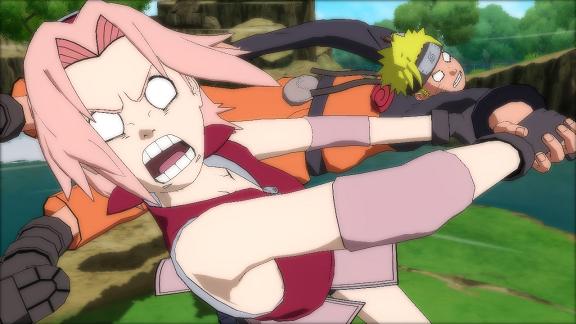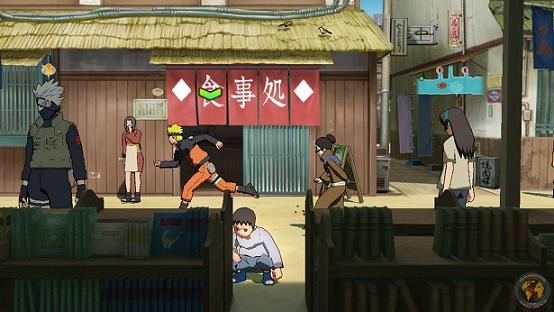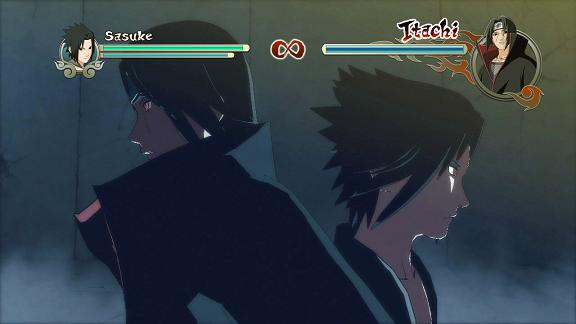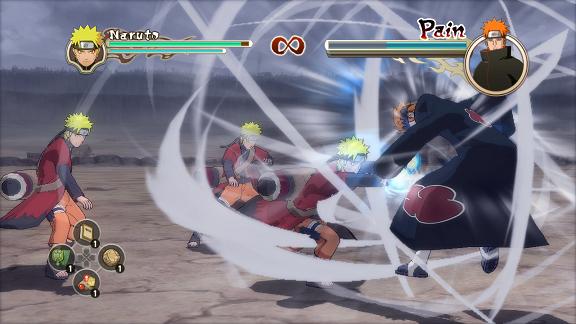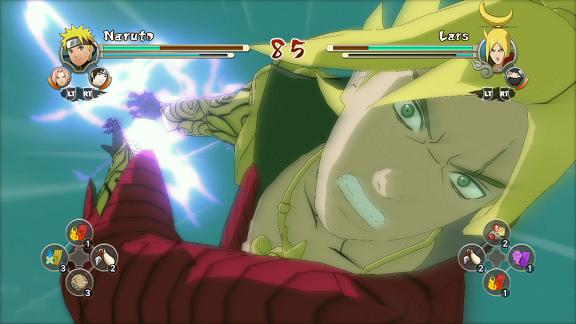Platforms: Microsoft Xbox 360, Sony PlayStation 3
Developer: CyberConnect2 – Publisher: Namco Bandai Games
Genre: Fighter
ESRB Rating: “T” for Teen (Ages 13 and up)
Before I get started, I just have to say that I love this game’s title like an armful of kittens. I mean, just look at it. “Shippuden” is already the subtitle for the anime series, but then the main series of videogames this belongs to gets the subtitle “Ultimate Ninja.” And then you realize that “Storm” is the subtitle for the sub-series that this game belongs to within the Ultimate Ninja series. And on top of that, you have a sequel number. And no, I did not intentionally label this game in an ungraceful way. Naruto Shippuden: Ultimate Ninja: Storm 2 is actually the way the game’s title appears in the copyright blurbs within the game itself.
I just find clumsy, gallumphing titles like that amusing. Call it my personal nerdish quirk.
But I digress. Although I’ve played some underwhelming anime tie-in games in my day, I find that they have a tendency to turn out better than other licensed titles — pretty much any licensed game ever developed by Electronic Arts, for example. Even so, they’re rarely anything to write home about. The Naruto series in particular had been (and maybe still is, I quit following the channel ages ago) a favorite lolcow of X-Play and a series most fervently hated-upon by many within the circles I hang around out here on ye good olde Internets.
Myself? I’ve always been a bit of a fan, actually — of the manga and anime, I mean. They aren’t the best, but they’re fun and entertaining enough for this anime enthusiast. Hell, once you get past the fact that HE’S NOT A NINJA GRRRRRAAAAAARRRR NERD RAAAAAAAGE!!!!!11!!1!ONE!!!!, you may just find that the characters and plotlines are actually quite engaging… overuse of flashback-exposition notwithstanding.
In terms of how well this game puts forward the story of its source material, the closest comparison out of the games I’ve played in the past would have to be Dragon Ball Z: Budokai, but Storm 2 is arguably much better in the story-presentation department than any of the Dragon Ball Z games I’ve played. Graphically and in terms of story, Storm 2 is quite like playing the first few major arcs of Naruto Shippuden with only a few important plot points left undeveloped and with (oddly enough) better animation and art quality than the majority of the anime series. And as a game, it’s not half-bad, either.
Now, before I go on, I want to be clear on one thing: I never had an opportunity to play the PlayStation 3 exclusive Storm 1, which covered the Naruto anime straight through from the beginning to Naruto’s showdown with Sasuke Uchiha (which marks the point where Naruto breaks off via three-year time-skip and becomes Naruto Shippuden). I know enough about the series to say that Storm 2 picks up after that time-skip, where Storm 1 left off. Playing both games back-to-back should give players a good alternative means to experience the entire Naruto saga from the beginning and on through to the end of the “Pain” arc, which covers the majority of the series so far. Not counting the abundance of filler in the anime or the various movies, that is. As for which of the two games is superior to the other, and in what ways one outshines the other, I haven’t the foggiest.
Storm 2‘s main attraction, I would guess, is its rather substantial single-player campaign. I’ll say this right now: I quite like it, both in terms of how well the story is told and how the gameplay elements tie together. It isn’t perfect, and can definitely use some fine-tuning in the overworld and RPG-elements department, but this is what fighting games need more of. I mean, think about it. “Arcade Mode” is nice, but on its own, obsolete. It’s designed for brief pick-up-and-play-at-the-arcade by-the-quarter stints, not dedicated single-player marathons. Too many fighting games have I played that either tack a one-or-two-scene “story” onto an arcade mode (see Super Street Fighter IV) or include a so-called “story” mode that is little more than a brief and insubstantial series of fights with a flimsy text-crawl story that does nothing but absolutely nothing. (I’m looking at SoulCalibur IV as I type this).
Storm 2 tells its story in a seven-chapter RPG-like mode in which the first batch of major story arcs following the events of Storm 1 are told with nearly as much grace as the manga and anime they originate from. The Naruto world is brought to life fairly well, in the form of pre-rendered backgrounds that the player explores in the style of the PlayStation 1 Final Fantasy games. By itself this is nothing remarkable; it’s actually the graphics that sell this so well. The cell-shaded character and object models are beautiful to behold atop these backdrops, which are drawn in the kind of painted style of inanimate anime backgrounds — an artstyle that the game even manages to carry into its occasional three-dimensional overworld areas, as well as into its battle arenas.
This overworld isn’t terribly interesting when you consider how it functions. Mostly it just provides a few arbitrary RPG and inventory elements that you’ll either make some minor use of or ignore completely. There are a nice assortment of side-missions to undertake, but the player doesn’t actually gain the freedom to play most of these — or to choose which characters they use in battles — until after the main story is complete. For the most part, it does what it’s supposed to: it ties the fights together and gives the game the breathing room it needs to tell its story in a cohesive way.
Fights themselves are fast-paced and fun, though they lack the depth and balance of more “hardcore” fighting titles. The game uses a three-dimensional behind-the-back style of play similar to the Dragon Ball Z: Budokai Tenkaichi games. Despite being perhaps a bit too simplistic and playing host to some blatantly overpowered characters, it captures the over-the-top action feel of the Naruto series to a T. My primary complaint is difficulty. The story mode is far too easy for the first half of the game, to the point where I spent most of my time spamming special moves with impunity and getting through without so much as a bump to the head. Once the difficulty does pick up, a few obvious flaws with the game’s mechanics come to light.
For starters, the evasion mechanic, “Substitution” (whereby the characters dodge by pressing the block button at the instant an attack hits) is far too finicky for the player to pull off, yet far too easy for the computer to abuse. This gives the computer yet one more unfair advantage over human players (on top of the usual — you know, being able to instantly block almost EVERYTHING with the reflexes of a goddamn Jedi, and so on), making single-player gameplay a pain in the butt during post-story sidequests or when the CPU difficulty in Free Battle mode is set higher than average. As a general issue, in both single-player and multiplayer, special attacks and ultimate attacks are far too spammable in spite of the game’s chakra gauge, since there isn’t really the sort of limiter that games like Marvel vs. Capcom 3 put on such attacks. They are, at least, much more dodgable than the ones in that game, but the old-school spirit of Hadouken-spamming lives on full-force in this one, and then some.
Speaking of Marvel vs. Capcom 3, this game does use a similar team mechanic. Unfortunately, it lacks the ability to “tag-in” other team members for direct control; the two supporting characters you choose will always be strictly there for support moves. This is interesting once you master how best to use it, as different characters have their own unique uses as back-up, which range from attack-based to defense-based to someplace in the middle. The more you use your assists, the more your “Team Gauge” will fill up, and as you fill more of it, your assist characters will start helping you automatically. Some of them will stand between you and the enemy as you charge chakra, or will attack your enemy of their own volition at no cost to you; once or twice, I was saved from certain death by an assist character who automatically jumped between me and an oncoming ultimate attack, taking the fall in my place. There is, of course, the obligatory “team ultimate” attack once you fill your gauge to the max, but that one explains itself.
Of course, just like that other game with the team mechanic, you’ll often find your opponents blindsiding you with a constant deluge of assist moves as you move to the higher difficulties, which is an aggravating, if not entirely cheap, aspect of the assist system.
By far the most annoying aspect of the fights is exclusive to the story mode’s main boss battles, however. As some of the hallmark fights in the story get far too wild or cinematic in nature to be contained within the confines of a fighting game, Naruto Storm 2 resorts to the most lowbrow, cop-out method of presenting these epic battle sequences: it interrupts its bosses with drawn-out quick-time events. These scenes are epic, and to its credit, the game’s QTEs aren’t overly difficult (they aren’t even randomized; memorization will work, if all else fails), and they only ever shave off a chunk of heath when you screw them up. All the same, the time limits on some of the QTEs are brutal and I often found myself scraping by within an instant of failure.
With one annoyance comes a hint of awesome, though. These same boss fights feature some good gameplay variety, with the bosses (and sometimes, the player’s character itself) busting out some massive transformations that keep the action feeling fresh. One or two of these segments are a bit frustrating until you get the method down, but it never gets obnoxious enough to kill the “wow” factor.
The story itself is done just enough justice for the subject matter. It certainly doesn’t hurt that the first four-or-five story arcs following Naruto‘s three-year time skip were some pretty gripping stuff in the first place. The voicework can be a bit stiff or cheesy at times, and the lip-syncing doesn’t even try to match the English lines, but the presentation overall is like watching an anime movie. Most of the time, like watching a particularly epic one.
A good chunk of the story is tied up in fixed-camera textbox dialogue (both with and without accompanying voices), but even the more pointless side-mission story scenes are presented in an amusing way, and all of the Naruto characters are perfectly spot-on in terms of personality. For a fan of the series, I can’t imagine it doing much better than it has. For newcomers, I can maybe picture one or two out of ten getting into the series through this game. Possibly.
There are a couple of places where (for, I suppose, the sake of brevity), a major scene or subplot lacks the punch or relevance it had in the source material. A major example would be Naruto’s new squadmate, Sai, whose motivation and character background go completely unexplained, and who just comes off as weird because of it. Those who play the game without knowing the story behind such things may spend a bit of time scratching their head with dumb looks on their faces. If you find yourself in such a state while playing the game, my recommendation is this: rock thee a Wiki.
In any event, someone at Capcom should play this story mode and pack a notebook. The next Marvel vs. Capcom game could take some good things from Storm 2.
Apart from the story mode, the usual bits and bobs are here: an offline versus mode, with both one-on-one and team-battle modes; an online mode; titles and avatar images to unlock; Achievements to hoard. The game contains a large roster of off-the-wall “those guys so totally aren’t ninja” fighters to play as, including just about every character from this chunk of the Naruto series in each of their individual bubbles of glory. The characters from the previous story arcs, such as Zabuza and Haku, are sadly absent. As a curious addition, one of the unlockable characters is Lars from the Tekken series, beautifully rendered in cell-shaded anime form. I… have no comment, not being a Tekken buff, but for what it’s worth, hey, I’ll take it.
Every character in the game captures the style and spirit it should in its own unique way, and none of them is so underpowered as to be useless. There are, however, a few that are vastly overpowered in some way or another. In the game’s defense, this is mostly their movesets and transformations being a little too loyal to the source material for their own good. I can see it being a real problem when you hit the online mode, though.
The long and short of it is this. Naruto Shippuden: Ultimate Ninja: Storm 2 is practically a must-play for any Naruto fan, and may be worth a rental for anyone who’s interested in the series but hasn’t gotten too deep into it yet. It’s fast, fun, and a worthy adaptation of what are, in this reviewer’s opinion, some of Naruto‘s best stories so far. And for those who know and love the world of Naruto already, it’s like spending the weekend with old friends.
I mean, c’mon. Nothing beats that.

